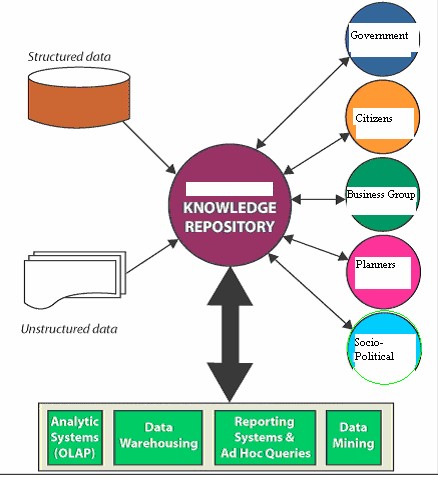Knowledge management (KM) is the management of information, skill, experience, innovation, and intelligence. It is the creation, capture, organization, access and use of knowledge.
It uses many technology categories, almost none of which are exclusive to KM. KM is a top down effort (practice) to try to understand and manage knowledge. KM may use specific practices such as collaboration, content management, email, video conferencing, work place tools, portals and business applications. The knowledge management is the one, which ultimately is to be used for planning and implementation of various government schemes and projects as shown in the figure

Managing knowledge involves managing domains of knowledge that are valued for achieving strategic objectives. The very nature of knowledge is that it changes fast and renders information obsolete at a rapid pace. Building knowledge management requires identifying and storing the collected information in an enterprise knowledge repository.
Knowledge Management has a much wider influence as it enables people to efficiently perform their functions and for citizens, the benefits include better services, more choices, more personalization and greater accountability of how their money is spent. For the -Government projects, KM provides the major benefit of improving the performance through increased efficiency and innovation. But these benefits need the back office processes to be in place.
Knowledge Management Process
Knowledge Management for E-Government projects is an ongoing process which consists of various phases for proper identification, storage and usage of knowledge. These phases are
- Undertake Knowledge Audit (Phase I) – This phase answers the questions like who collects what information? Why is it collected? Is it collected in time? Is collected knowledge put to any use? Is there a better way of collecting knowledge? Is required information being collected?
- Create Knowledge (Phase II) – It focuses in taking stock of existing knowledge and assessing knowledge needs of the organization. Determine who will create what information, when and in what format? Use knowledge management (KM) tools for knowledge creation.
- Capture Knowledge:(Phase III) – It deals with the transformation of tacit knowledge into storable explicit knowledge. It deals with activities like recording one-to-one conversations, recording a brainstorming session, recording minutes of meetings and other proceedings. It also deals with recording success profile of individual e-government champions.
- Store Knowledge (Phase IV) – This phase of the KM cycle deals with organizing knowledge into codifiable and non-codifiable categories. Use of electronic media for knowledge storage is also encouraged. Opening a dedicated knowledge centre at office which is implementing an e-Government project is a good practice. The knowledge centre should identify and use “best practices” in knowledge storage and should disseminate the same to the intended audience.
- Use Knowledge (Phase V) – Knowledge captured and stored should be made accessible to all concerned personnel. A culture of knowledge sharing should be promoted within the organization. Setting up knowledge distribution and knowledge sharing mechanisms within the organization will help the KM cause. Providing knowledge inputs to policy makers and monitoring knowledge use will help in taking mid-course correction measures.
- Review Knowledge (Phase VI) – This phase deals with anticipating future knowledge needs by reviewing the existing stock and flow of knowledge by making use of simple but effective knowledge indicators.

